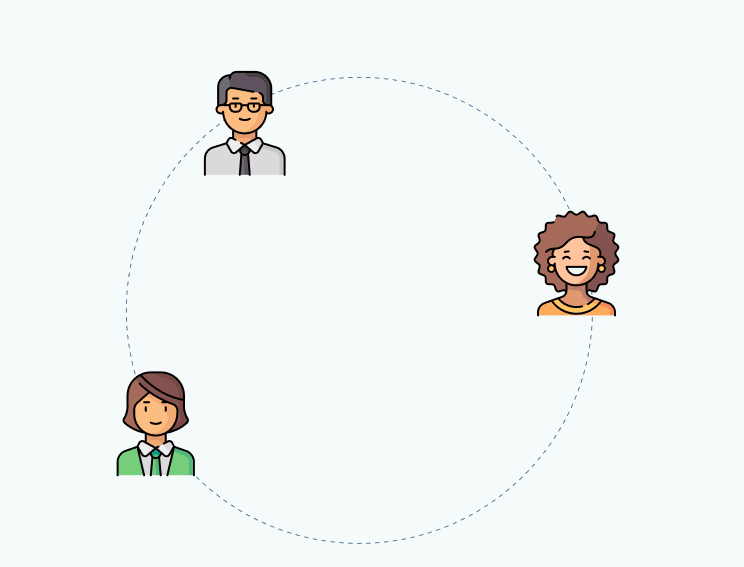
Your New Intranet Starts Here
Streamline communication, boost collaboration, and empower your team with MyHub's intuitive intranet solution.
Book a live demo now and experience the difference.
Take a Quick TourWhy Universities Need a Modern Intranet Solution
It almost goes without saying that universities are knowledge hubs. Students, lecturers, and administrative staff come together to learn, share, and collaborate. However, the sheer size and complex structure of universities can also lead to significant administrative and communication challenges. Disconnected systems, departmental silos, and constant information overload can make everyday interactions confusing and frustrating for both staff and students.
Fortunately, it doesn’t have to be this way. With the right tools, universities can modernize their infrastructure. This post explores how university intranet platforms can transform the employee and student experience. We’ll also showcase best practice examples from real-world deployments of intranet systems in universities around the world.
Why Many Universities Lag Behind Intranet Adoption
While businesses have fully embraced the digital workplace, many universities have been slow to follow suit. In cases where intranets do exist, they are often outdated, underutilized, or difficult to navigate. The result? Faculty and students resort to external tools like social media and messaging apps for communication – often at the expense of privacy, data security, and productivity.
During the COVID-19 pandemic, teaching and learning rapidly moved online out of necessity. Now that campuses are reopening, the time is ideal for universities to re-evaluate their intranet solutions. A modern university intranet provides a centralized platform for connection, collaboration, and communication – making it a key differentiator in a highly competitive online education market.
Top 5 Benefits Of Modern University Intranets
Just like corporations, universities aim to improve productivity, collaboration, and internal communication. A modern intranet can help meet those goals while also simplifying administrative workflows and enhancing student engagement. Here are five compelling reasons why a university should invest in a modern intranet solution.
1. Smarter Knowledge Sharing
A university intranet acts as a centralized knowledge management system. Faculty and students can upload, organize, and access information from a single platform – eliminating the need for multiple databases and systems. Whether it’s course material, research publications, or administrative forms, everything lives in one easily accessible space.
Advanced search functionality allows users to filter by tags, titles, authors, or topics. With results previews and intuitive navigation – whether organized by department or user-based needs – students and staff can find relevant content quickly and easily.
2. Easier and More Efficient Collaboration
University intranets enhance collaboration by providing dedicated project spaces for research teams, departments, and student groups. Secure and private areas allow users to brainstorm, share files, and exchange feedback – even across campuses or time zones.
Integrated tools such as Google Workspace and Microsoft Office enhance the collaborative experience by offering familiar environments for document sharing, task management, and real-time editing. Instructors with a childhood education degree can design engaging and interactive activities for students directly within the intranet environment.
3. Improved Internal Communication
Effective internal communication is vital for any academic institution. A modern university intranet allows for engaging multimedia content, including videos, images, and announcements – all delivered via a user-friendly interface.
Automated notifications, customizable alerts, and responsive mobile access ensure that users never miss an important update. Personalized dashboards and content preferences help avoid communication overload, making sure users receive only the information relevant to them.
With built-in user analytics, universities can track content engagement and adjust their communication strategies accordingly – ensuring consistent and impactful messaging.
4. Foster Campus Connections Virtually
One of the biggest advantages of campus life is the ability to meet like-minded individuals and form lasting professional networks. In times of physical distancing or remote learning, a socially enabled intranet fills this gap by fostering meaningful online connections.
Features like searchable staff and student profiles, activity feeds, and instant messaging allow users to interact, share ideas, and form communities. Whether it’s a shared interest in a research area or a student club, the university intranet helps build a vibrant digital campus culture.
5. Streamlined Administrative Processes
Universities deal with a vast amount of paperwork and procedural tasks. From admissions to HR operations, a modern intranet transforms these manual processes into streamlined digital workflows.
With built-in form builders and automated routing, tasks like course registration, onboarding, or even booking vacation leave become fast and efficient. The intranet automatically directs submissions to the correct departments, eliminating bottlenecks and reducing errors.
Granular permission controls ensure that sensitive information remains secure. Role-based access, two-way SSL encryption, and audit trails protect data integrity and maintain compliance with privacy regulations.
Real-World Success: How Leading Universities Use Intranets
The five features highlighted above demonstrate how intranets can revolutionize campus operations. But how does it work in practice? In our next section, we’ll showcase real-world examples of university intranets in action – from globally ranked institutions to innovative local colleges – revealing how these platforms enhance the student and staff experience.
University Intranets: Real-World Examples
Augusta University, US – Personalized Access for Staff and Students
The Augusta University intranet serves as a combined digital portal for both students and staff. It offers centralized, single-point access to academic tools and resources. A key feature of the platform is its option to create a personalized user experience, where visitors can select a student or faculty-specific interface.
A sidebar menu highlights popular tools and apps, grouped under relevant categories like campus life, academics, and student resources.
Visually, the homepage stands out through its use of vibrant colors, imagery, and graphical elements, enhancing user engagement.
The portal also features a logical information architecture that ensures intuitive navigation and quick content discovery.
Yale School Of Medicine, US – Role-Based User Experience
Part of Yale University, the Yale School of Medicine intranet delivers a robust digital platform tailored to a wide range of users. The ‘Information For’ tab on the homepage header directs alumni, students, researchers, and staff to their own customized navigation panels.
A well-structured sidebar presents key resources in A–Z format, offering easy access to calendars, events, parking, and library services.
The interface blends functionality with appealing aesthetics, using news headlines, graphics, and event sections to enhance user engagement.
Aligned with modern intranet design standards, the portal features ample white space and a clean layout. A highly visible search bar in the header further streamlines content discovery.
University Of Birmingham, UK – Dual Navigation for Students and Staff
The University of Birmingham intranet offers a dynamic and user-centric homepage designed to serve both students and staff. News, announcements, and timely updates are featured prominently, with dedicated menus for each user group.
The top six most-used tools are clearly displayed. For students, options include student help, digital services, and library access. Staff can quickly reach the staff directory, campus maps, and the IT portal.
A prominent search bar and detailed menus support easy navigation and rapid content access.
To support continuous improvement, the university integrates an intranet feedback tool, empowering users to contribute ideas and suggestions for future enhancements.
University Of Sydney, Australia – Staff-Focused Portal with Integrated Systems
The University of Sydney intranet has been purpose-built with staff as its primary audience. The homepage design is colorful and image-rich, drawing attention to key resources and making the interface more inviting.
The intranet emphasizes access to essential systems such as timetabling, campus assist, and Office 365. Up-to-date news and announcements are also featured prominently.
Crucially, the platform offers integrated login access to various university systems, including academic planning and research data management tools – streamlining the user experience.
Cardiff University, UK – Clear Navigation and Role-Based Resources
The Cardiff University intranet is a unified platform that serves both students and staff. The interface is designed for ease of navigation, with critical links and tabs made easily accessible.
Students can quickly access high-demand services such as accommodation, libraries, and exam information. Meanwhile, staff are directed to resources for recruitment, training, development, and performance reviews.
By prioritizing clarity and simplicity, Cardiff University has developed an intranet that supports the needs of a diverse academic community.
Break Down Departmental Silos With a University Intranet
As the examples above show, a modern university intranet plays a vital role in breaking down departmental silos. Traditionally, universities relied on scattered tools and fragmented communication channels to manage information, resulting in a confusing and disjointed experience for both staff and students.
Today’s best-in-class intranet solutions move beyond this outdated structure. They instead focus on delivering a unified digital experience centered around the needs of students, faculty, and administrative staff.
Here are just a few of the key benefits of university intranets:
- Smarter knowledge sharing across departments and teams
- Streamlined collaboration for academic and administrative functions
- Faster processing speed of college marketing tools, and more efficient college marketing initiatives as a result
- Improved internal communications and transparency
- Greater opportunities for student and staff engagement
- Optimized workflows and simplified business processes
And most importantly, these improvements lead to an enhanced user experience that sets your institution apart. In an increasingly competitive online education market, delivering a seamless and intuitive intranet can make all the difference in attracting and retaining students.
Launch Faster: University Intranets Made Easy With Templates
The best part? Launching your university intranet doesn’t have to be complicated or time-consuming.
Pre-configured intranet templates make deployment fast, simple, and cost-effective. These templates are fully customizable and come pre-loaded with the latest coding standards, design best practices, and built-in functionality.
Key features include:
- Page permissions and admin tools for secure access control
- Responsive mobile design for users on the go
- Enterprise-grade security and safety protocols
This proven technology is already used by educational institutions and businesses worldwide. And thanks to an affordable monthly subscription, you’ll enjoy unlimited data storage and user access without unexpected costs.
Getting started is easy. Just choose your templates and follow MyHub’s intuitive five-step site builder wizard – no coding or technical expertise required.
Ready to Transform Your Campus Communication?
If you’re looking to streamline operations, unify communication, and elevate user experience across your campus, now is the perfect time to act.
Get started today with a free demo or take advantage of our 14-day no-obligation trial. Discover firsthand how a modern university intranet can help you break down silos and future-proof your institution.
FAQ Section
What is a university intranet?
A university intranet is a private, secure network that facilitates communication, collaboration, and information sharing among students, faculty, and staff within an academic institution.
How does an intranet benefit students and staff?
An intranet provides centralized access to resources, enables real-time communication, supports collaborative projects, and streamlines administrative tasks, enhancing the overall educational experience.
Can a university intranet integrate with existing systems?
Yes, modern intranets can integrate with various tools and platforms, such as learning management systems and productivity suites, to provide a cohesive and efficient user experience.


